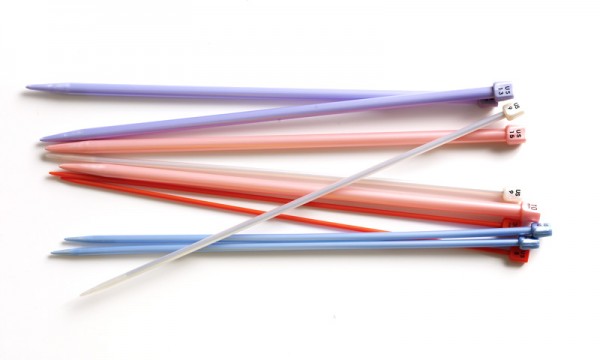Technical editor and yarncrafting expert Kj Hay joins us for a series on understanding the different elements of patterns. Click here to read her earlier blog posts.
 The sizes of the hooks or needles listed in a pattern indicate the size used by the designer to achieve the listed gauge and to complete the item shown. Gauge is the number of stitches and rows worked in a piece fabric of a certain size. The hook or needle size helps determine the gauge and the gauge determines the size and drape of the fabric. Different knitters and crocheters, even when they use the exact same size hook, yarn, and pattern stitch, will often create fabric of different gauge. Accordingly, you may need to use different size hooks or needles to achieve the same results as the designer. Begin with the listed size, but check your results and be willing and prepared to change to a different size (see Gauge section below for more details).
The sizes of the hooks or needles listed in a pattern indicate the size used by the designer to achieve the listed gauge and to complete the item shown. Gauge is the number of stitches and rows worked in a piece fabric of a certain size. The hook or needle size helps determine the gauge and the gauge determines the size and drape of the fabric. Different knitters and crocheters, even when they use the exact same size hook, yarn, and pattern stitch, will often create fabric of different gauge. Accordingly, you may need to use different size hooks or needles to achieve the same results as the designer. Begin with the listed size, but check your results and be willing and prepared to change to a different size (see Gauge section below for more details).
Hooks and needles of different types may also be indicated. Knitting needles come in straights of different lengths, circulars of different lengths, and double-pointed. Crochet hooks can be standard, Tunisian, or double-ended. Be sure that you have (or are willing to acquire) the skill needed to use specific hooks and needles, especially double pointed knitting needles or Tunisian or double-ended crochet hooks.
The hook and needle sizes listed may or may not be the same as the recommended size listed on the yarn ball band. The recommended size listed on a ball band is a size needed for a fabric of average drape (or firmness) made from the most basic of pattern stitches (single crochet or Stockinette st). A specific project is likely to warrant a different drape and the use of pattern stitches other than the basics, thus needing a different size hook or needles.
A circular needle does not always indicate that a project is worked in rounds. Very wide items are often knit back and forth in rows on circular needles as if working with straight needles. In fact, even when straight needles are specified, you may be more comfortable using a circular needle.
Stitch markers, stitch holders, cable needles, buttons, zippers, stuffing, sewing needles and thread, blocking materials, and yarn needles are commonly needed to successfully complete a project. Take care to select notions appropriate for the project. You will want larger or longer stitch holders and cable needles for projects worked with thicker yarns. You will want removable or locking stitch markers for crochet projects, but may need only ring markers for knit projects. It is usually best to have a variety of stitch markers available so that you can select the correct type when you reach the place within the instructions that require the use of a marker.
It’s wise to wait until your piece is complete or almost complete before purchasing buttons, clasps, and zippers. If you wait, you can hold the piece up to the buttons, etc. to determine if the size and color are appropriate.
Related links:
themis
the material hooks and needles are made of is also important. some yarns are so slippery they need wooden or bamboo to ‘slow them down,’ but a slick smooth needle will work great with a fuzzy yarn.